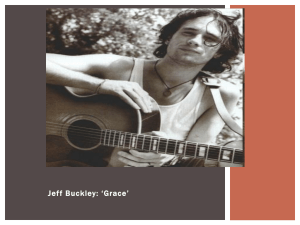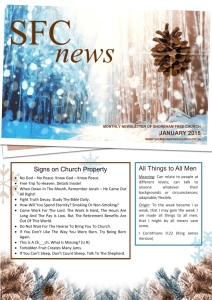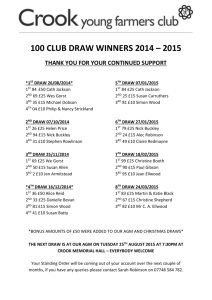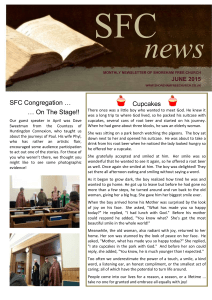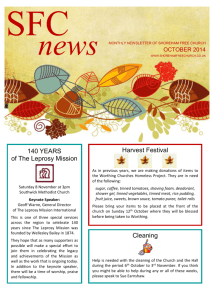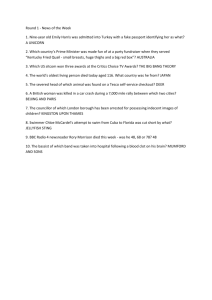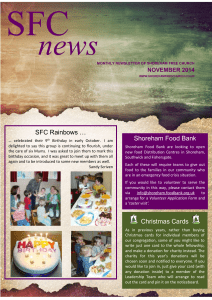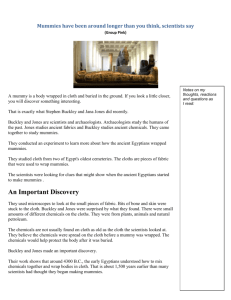June tour - Jan `Yarn` Wositzky
advertisement
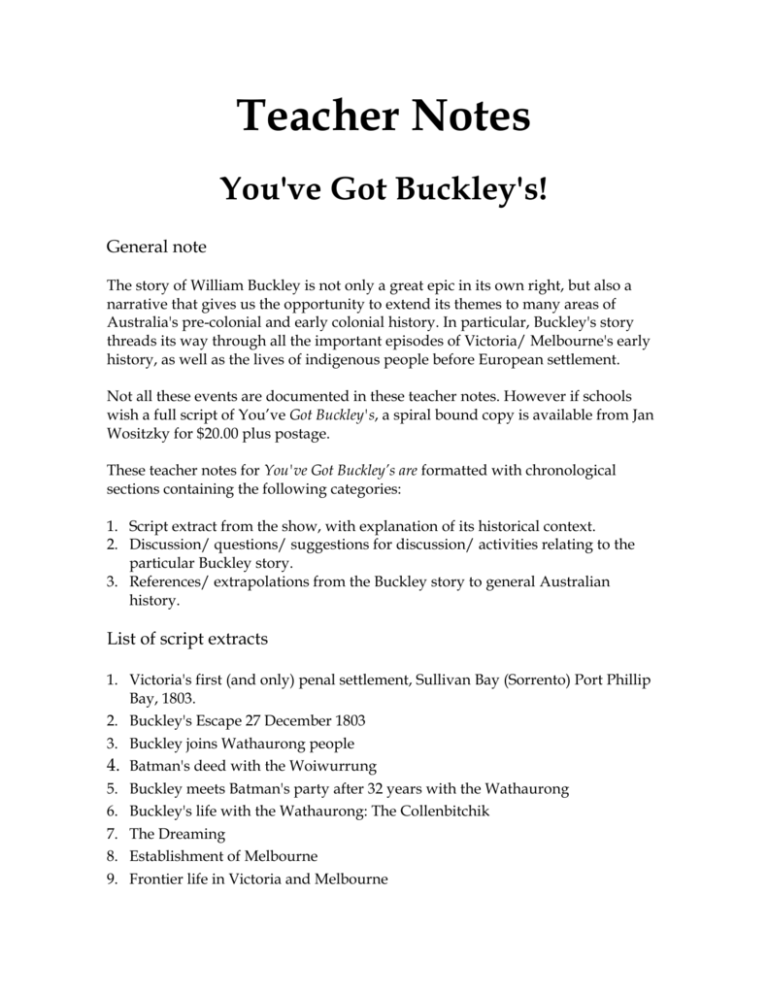
Teacher Notes
You've Got Buckley's!
General note
The story of William Buckley is not only a great epic in its own right, but also a
narrative that gives us the opportunity to extend its themes to many areas of
Australia's pre-colonial and early colonial history. In particular, Buckley's story
threads its way through all the important episodes of Victoria/ Melbourne's early
history, as well as the lives of indigenous people before European settlement.
Not all these events are documented in these teacher notes. However if schools
wish a full script of You’ve Got Buckley's, a spiral bound copy is available from Jan
Wositzky for $20.00 plus postage.
These teacher notes for You've Got Buckley’s are formatted with chronological
sections containing the following categories:
1. Script extract from the show, with explanation of its historical context.
2. Discussion/ questions/ suggestions for discussion/ activities relating to the
particular Buckley story.
3. References/ extrapolations from the Buckley story to general Australian
history.
List of script extracts
1. Victoria's first (and only) penal settlement, Sullivan Bay (Sorrento) Port Phillip
Bay, 1803.
2. Buckley's Escape 27 December 1803
3. Buckley joins Wathaurong people
4. Batman's deed with the Woiwurrung
5. Buckley meets Batman's party after 32 years with the Wathaurong
6. Buckley's life with the Wathaurong: The Collenbitchik
7. The Dreaming
8. Establishment of Melbourne
9. Frontier life in Victoria and Melbourne
Further reference material
Books
Hill, Barry (1993) Ghosting William Buckley. William Heinemann Australia.
Morgan John (1852) The Life & Adventures of William Buckley. New edition
introduced and edited by Tim Flannery. Text Publishing.
Robertson Craig (1982) Buckley's Hope. Scribe Publications.
Websites
Friends of William Buckley
www.williambuckley.org
Information on John Fawkner and his ship, The Enterprise
www.enterprize.com.au
The Script Extracts & Discussion
Script extract No. 1: Victoria's first (and only) penal settlement,
Sullivan Bay (Sorrento) Port Phillip Bay, 1803.
"Aboard that convict ship was William Buckley,
23 years old and transported for life with hard labour...
On the voyage Collins had noticed Buckley
- after all, if you're 6 foot 7 in a time when most everyone is 5 foot 6
you're going to stand out.
(Ron Barassi would have had him off the boat and into the ruck the first
afternoon)
Also aboard was a ten-year-old boy, John Pascoe Fawkner,
with his father, transported for robbery.
Don't forget the boy... he'll be part of this story when he grows up.
The ship was called The Calcutta
and October 9, 1803 they slipped through the heads of Port Phillip
and landed at Sullivan Bay a place we now call Sorrento.
Collins declared:
'This shall be the place for a Pizza Hut, and a fish and chip shop,
where people can build holiday houses and their teenage children can get
drunk and fornicate in the tea-tree all the summer long!'
And at Sullivan Bay, Sorrento, Koonan,
William Buckley was set to working in a quarry, for he was a
bricklayer."
Context
It's a barely understood fact that Sorrento on Port Phillip Bay was the first attempt
at European settlement in what we now call Victoria. Lt. Col. David Collins,
formerly Judge Advocate with the First Fleet at Sydney Cove led the ‘expedition’.
Further research/ discussion
The Sullivan Bay settlement was 15 years after the First Fleet arrived in NSW.
What stage was Sydney up to in 1803. How far had white settlement spread?
Discuss the British need to claim the south coast for fear that the French would
colonise that part of Australia. (Imagine if Melbourne were a French city!)
The other name mentioned in the script for Sorrento is Koonan, a Bunerong
word
On Map 1 (below) locate Bunerong (Boon Wurrung) country
Locate on Map 1 where you live. What is the name of the Aboriginal people
whose country it is? What do you know of these people? Are they still around?
What place names in your district come from the local Koori language? What
place names come from the European settlers?
Script extract 2: Buckley's Escape 27 December 1803
Context
Two days after Christmas, 1803, William Buckley and two companions bolt from
Sullivan Bay and in four days run around Port Phillip Bay to Swan Island at
Queenscliff. From there they can see the settlement at Sullivan Bay (Sorrento) just a
few miles across the water. Buckley's companions, too frightened to go on, walk
back, leaving him alone. He said in his 1852 book, The Life & Adventures of William
Buckley:
"To all their entreaties to accompany them I turned a deaf ear,
being determined to endure every kind of hardship rather than
again surrender my liberty.
When I had parted from my companions, I thought of the
slavery of my punishment and of the liberty I had
panted for, which although now realised, after a fashion, made
the heart sick, even at its enjoyment.
How I could have deceived myself into a belief of ever reaching
Sydney is to me astonishing...the whole affair was, in fact, a
species of madness.
I was now in a land where no one I knew had ever been."
Further research/ discussion
Look up a map of Victoria and locate their position on Swan Island.
Using Map 1 locate where Buckley is and on which Aboriginal land?
(Wathaurong/ Watha Wurrung).
On a map of all the Aboriginal language groups in Australia** locate
Wathaurong country within the 350 or so original indigenous groups
of Australia.
How many other groups have you heard of?
** There is an excellent map of Australia wide Aboriginal groupings
available from the Institute of Aboriginal and Torres Strait Islander
Studies, Canberra
Details on where to get the map:
Aboriginal Australia Map ($24.95). Can be ordered from book stores
through Peribo.
Script extract 3: Buckley joins Wathaurong people
Context
By the winter of 1804 William Buckley is nearly dead from starvation and cold. He
decides to return to Sullivan Bay. At Torquay he finds a spear stuck into a mound
of earth and he takes it for support. Near a swamp, which is located at the back of
the Barwon Heads Golf Club, Buckley meets Wathaurong people. He is about to
begin an astonishing 32 years living as an Aboriginal.
That afternoon, by a swamp where black swans paddle,
he collapses under a tree, the spear at this side.
'Amadiate. Amadiate.'
The tree, the swamp, the swans - everything in this country has a name.
'Amadiate'
('Amadiate' - we now know - is a spirit returned from the dead, and
spirits returned from the dead are always white.)
'Amadiate! Amadiate!'
Buckley opened his eyes to see six black men and two black women
looking down at him:
'Murrangurk! Murrangurk'
(Murrangurk, we now know, was a warrior who died, and Buckley had
taken the spear from Murrangurk's grave.)
He is fed gum:
'gurring gurring'
and grubs:
'milork milork'
and led around the swamp to a camp, where the men paint their bodies
and the children light a bon-fire.
The women scream, pull out their hair, and take stones and
(smash into head) the blood flows .
They stretch possum skin coats across their knees and beat them as a
drum.
(He is now the spirit of Murrangurk about to be welcomed back from the
dead...but Buckley, terrified, thinks he was about to be dinner.)
The musicians bang sticks and the painted dancers stomp backward and
forwards.
The sun sets. The wind drops. The stars come out. The moon rises.
Then: Oooooop! Oooooooop!! Ooooooooop!!!'
and everyone came up and shook his hand, beat their chests
and smiling, welcome Murrangurk back from the dead.
Further research/ discussion
Note that at this point in time Collins has disbanded the settlement at Sullivan Bay
and sailed across Bass Strait to establish Hobart, so from here discussions can lead
to why the settlement was aborted (lack of water) and the colonial history in
Hobart.
The Wathaurong took Buckley in as a spirit returned from the dead. There are
many accounts of this belief that led to white people being initially confused with
spirits.
This belies any simplistic account of the initial contact between European settlers
and indigenous people, and from this starting point students can examine the
mixed relationships between the two races in our history:
that within 3 weeks of the First Fleet arriving black and white people were
trying to get on by dancing together (see Inge Glendinnen, Dancing With
Strangers, Text, 2003)
massacres and disease
co-operation in some areas with Aborigines showing explorers the way, and
Aborigines also fighting back when they realised they were losing precious
land and resources
from such varied beginnings can be traced the path to the developments of the
Land Rights movement and self-determination
In the Buckley story this beginning is the deed by which John Batman 'purchased'
the Port Phillip District land from the Woiwurrung traditional owners, a
development which was to engulf William Buckley.
Script extract 4: Batman's deed with the Woiwurrung
Context
By 1835 the settlers in Tasmania had run out of land they could farm so they
started looking across Bass Strait. John Batman became an instigator of a private
company, the Port Phillip Association (PPA), and came to explore the country
around Port Phillip Bay. On June 6, 1835 John Batman and members of the
Woiwurrung signed a legally prepared deed, whereby the PPA supposedly
purchased 500,000 acres of land:
John Batman:
I was shot of convict seed.
I was born of convict loins.
I am the greatest landowner in the world!
Land! Land, land, land land - land! As far as the eye can see
land, like a virgin waiting for the plough all for the payment of:
20 pair of blankets
30 tomahawks
100 knives
50 pair of scissors
30 looking glasses
200 handkerchiefs
100 pounds of flour
6 shirts
and similar goods in rental each year for Land! 500,000 acres of land!
Signed by Jagajaga! Jagajaga and Jagajaga.
The Woiwurrung understood that I too am native born.
I bring them civilisation! - as far as the eye can see!
I was shot of convict seed.
I was born of convict loins.
I am the greatest landowner in the world.
Jan Wositzky speaks:
I rang LJ Hooker's head office: 'I want to buy Melbourne, Geelong and
the Bellarine Peninsula including Mietta's at Queenscliff, how much?'
They said they'd do lunch on that one.
Meanwhile I shot down to Target and Mitre 10, and checked the price
racks - 30 tomahawks...100 knives...50 pair of scissors... 6 shirts etc...
$1427.43.
When the woman from LJ Hookers rang back she said they'd had great
fun working it out: Melbourne, Geelong, Bellarine Peninsula...$75
billion.
When I told her what Batman paid for it, she said, 'What's a
tomahawk?'
Further research/ discussion
Batman's deed with the Woiwurrung underscores some complexity in colonial
relationships between the settlers and Aboriginal people.
Batman had come from Van Diemen's Land (Tasmania) where Aboriginal people
had been virtually wiped out as the British settlers took over the land. Batman and
the Port Phillip Association wished to avoid such bloodshed in Victoria, hence the
deed to purchase the land. But the deed lasted only 81 days, because on 26 August
1835, Governor Bourke in Sydney declared the deed null and void, and so the
purchase was rendered illegal.
This may have been the beginning of the famed Melbourne-Sydney rivalry, but
more importantly, did Bourke act to nullify Batman's deed because the deed,
ridiculously unfair as it was, at least acknowledged the Aboriginal people as
owners of the country who could trade in their land? Did the deed make
Sydney look illegal?
Or was it just because Port Phillip was out of the control of the NSW
government?
Discuss Batman's deed in the context of the issues raised by the Land Rights
Act of 1975 and the Mabo and Wik legislation of the 1990's. The Mabo case in
particular raised and debunked the idea of terra nullius - the idea that the land
was vacant at the time of European arrival.
Discuss how could the land be regarded as unoccupied - with such ideas as
because Aboriginal people did not necessarily build permanent houses and
tend gardens as we know it, that Europeans believed there was no sense of
ownership.
Script extract 5: Buckley meets Batman's party after 32 years with the
Wathaurong
Context
The dilemmas, conflicts, differences and misunderstandings between British
settlers and Aboriginal people all visit themselves upon William Buckley when he
learns that there is a party of white men camped on the coast at Beangala, now
known as St Leonards.
These men are Batman's holding party and they are the first Europeans Buckley
has seen since his companions left him at Swan Island, 32 years before. He cannot
remember English. His name is now Murrangurk. Batman's party is astonished to
see this giant European dressed in possum skin. But soon he is dressed in trousers
again and becomes the go-between, trying to keep peace between both parties:
At dark-time Bullbul arrived with a band of men, spears a-rattling.
Bullbul was amazed at Murrangurk's get up the cloth wrapped around so tight he could hardly walk,
so very tight in the crutch.
'We will kill white men.'
'If you do that they will send many more to kill us all,'
(to white camp)
'You must make gifts. Food. Biscuits.'
(to black camp)
'The white men will give you biscuits. Do not kill them, they have many
more with guns.'
When his English was sufficiently returned to hold a conversation,
Buckley asked the men under the Union Jack what they were doing in
Wathaurong country.
Gumm, the leader, said, 'Our employer, Mr John Batman has purchased
this land off the native chiefs.'
'Which chiefs?'
'The ones at the river at the north of the bay. Jagajaga, Jagajaga and
Jagajaga. They signed Mr Batman's deed.'
'What deed?'
'As prepared by Mr Gellibrand, the solicitor for the Port Phillip
Association.'
'And what did Mr Batman provide for the chiefs?'
'20 pair of blankets
30 tomahawks
100 knives
50 pair of scissors
30 looking glasses
200 handkerchiefs
100 pounds of flour, and
6 shirts
'And what land did Mr Batman purchase?'
'The land from the Yarra Yarra, as far as the eye can see.'
'So why are you here, at Beangala?'
'Mr Batman also purchased this land, from the same chiefs.'
Said Murrangurk, 'The river in the north is Woiwurrung country. This
is Wathaurong country.'
But Gumm replied, 'We are authorised to chase intruders off Batman's
property.'
Said William Buckley, 'There is no one can sell the land!'
Once, when Bullbul had run out of patience, he threatened to kill
Murrangurk as well. Buckley went amongst the Wathaurong with a
gun:
'I will shoot anyone who spears these Englishmen,'
At this point of the story I'm not sure what to call our hero
- Buckley or Murrangurk and for a month he wore a path between the two camps
till the flour ran out, and the Englishmen
'...commenced eating Roots the same as the natives,' Then the boat returned, with Biscuits! Grog! and fast food and drugs came to stay.
And on the beach that night there was a great corroboree
with Batman's men and the Wathaurong
who sang and danced around the fire and Murrangurk-Buckley stood in the middle,
his spears in one hand, bread in the other.
Might it have been that Buckley could have sung to the Wathaurong a
Cheshire song of the birds a-singing in the merry months of May, and
might Murrangurk have sung to the Englishmen the Wathaurong song
of Barroworn, the magpie?
Might they all have been singing together?
Dancing together? Laughing at the others' wacky pronunciation and
wobbly dance steps... (They did exactly this in Sydney 3 weeks after
white settlement...)
Might we have inherited such a world instead of now trying to put it
together like a window from broken shards of glass?
Or am I just a 21st century dreamer who's never been around a campfire
where the only god is God, with guns to back it up; where those who live
in the Garden of Eden have no idea that they were born sinners and
cannot imagine that anyone would buy, sell or take their land or slice it
with lines on a map?
And if the twin souls of Murrangurk and Buckley
could ever survive around that campfire, that would depend
on whether the white settlers would ever call him 'Murrangurk'...
but in the ashes of the dawn they named him 'The Wild White Man'
Further research/ discussion
The above passage contains a lot of issues Australians have been grappling as the
nation waxes and wains on the issue of reconciliation between indigenous and nonindigenous Australians:
The Aboriginal idea that people belong to the land verses the European idea
that people own the land.
The clash of spiritual faiths.
The possibility that through song and dance, black and white Australians can
find common ground.
The coming to terms with the fact that with 350 Aboriginal groupings and as
many languages at the time of colonisation that two groups of Aboriginal
people may be as different to each other as the Greeks and the Turks or the
French and the Germans.
That a sense of Australia wide Aboriginality has been a necessary survival
response to European occupation of the land.
All the above issues confronted William Buckley in 1835 when the settlers returned
to colonise Victoria and establish Melbourne.
Script extract 6: Buckley's life with the Wathaurong: The
Collenbitchik
Context
In this extract concerning Buckley's life with the Wathaurong we are again made
aware that the various tribal groupings of Australia were interconnected but
separate nations who did not always get along without conflict.
This passage also looks at Buckley's deep relationship with the Wathaurong:
It happened at a time long after Murrangurk had forgotten English;
when he could hunt with the best of them; after he'd witnessed many
fights: seen old people die and kids grow up - when one day
Murrangurk with his family - Torraneuk, Wombalano Beear, and the
children, Burmbo Merio and Miri Mallo, and others - were camped in
the magenta bushland up the Barabool.
They receive news that the head-man of the Collenbitchik,
a neighbouring clan, has died from the bite of
kaan tiger snake kaan
Then the kids get bitten by some
collenbitchik bullants collenbitchik.
and next morning sixty Collenbitchik
appear over the creek, shiny with ochre,
shaking spears, yelling for the blood of Torraneuk,
screaming revenge because it was Torraneuk
that sent kaan, tiger snake, to assassinate their head-man.
'Mung,' they cry, 'mung' - sorcery - and the collenbitchik advance,
spears raised.
*
Wombalano Beear grabs the children, she runs in a panic.
Murrangurk stands with Torraneuk.
Torraneuk's face is taught.
Torraneuk falls with a barbed spear through his shoulder.
Wombalano Beear is dragged from the bushes, clubbed to her last breath
and speared. Torraneuk sees his wife die.
He grabs a spear off Murrangurk, and wounds one collenbitchik.
The collenbitchik fall on Torraneuk, club him to the ground.
Torraneuk passes away in Murrangurk's arms
and Murrangurk realises he'd known Torraneuk as a brother,
but not as
wirrarap sorcerer wirrarap.
Buckley
I suffered the deepest mental anguish from the loss of these
people, who had all along been so kind and good to me. I am
not ashamed to say that for several hours my tears flowed in
torrents. To them I was a living dead brother, whose safety
was their sole anxiety. Of all my sufferings, there was
nothing to equal the agony I now endured. I wept
unceasingly.
Script extract 7: The Dreaming
Context
When William Buckley met the settlers who came in 1835 he was not only a fluent
Wathaurong speaker with family; he also had a totem - Barroworn, the Magpie and so, as Murrangurk, he was part of the eternal cycle of the Dreaming.
SCRIPT EXTRACT
'barroworn barroworn'
That's what Torraneuk, his brother, said, jabbing Murrangurk in the
chest one time they were sitting by a creek: 'You! Barroworn. Magpie.'
And if Torraneuk had had any English he might have told it like this:
'One time, eberijing been dark. Dat sky, him bin lie down,
all a way longa dis earth. No light. One day Barroworn, magpie, bin
say: "Hey you mob, you all about get stick, and poke im up la sky."
So all about magpie, Barroworn, bin gettim stick, and pushim up dat
sky. Pushim up past rock; pushim up past tree; then they pushim hole
in dat sky and strait way light, and barroworn all about sing for mere,
sun. Dat you Murrangurk, you Barroworn.'
Sing
Oh magpie, barroworn
Oh magpie, barroworn
Truth is, time was a darkness
Truth is, time was a darkness
Till they put the sticks up
And raised the sky.
Oh magpie, barroworn
Oh magpie, barroworn
Further research/ discussion
In this story, like the Christian creation story, there is a time of darkness before the
light, the light in both instances being created by a deity. In many accounts of the
Dreaming across Australia there is the presence of a serpent as creator, and also
floods, both motifs having echoes in many creation stories around the world.
Explore various accounts of what the Dreaming is and try to form your own
picture of what it is as a spiritual system.
Script extract 8: Establishment of Melbourne
Context
It was out of this world that Buckley walked to meet Batman and the other settlers
who came in 1835. Within a month he was granted a pardon by the Government
and employed as Interpreter for the Port Phillip Association (PFA). In August
Buckley went with the PFA to the spot Batman had chosen for a village, and so
Buckley was a participant in the establishment of Melbourne. By this time Gov.
Bourke had declared Batman's deed null and void and when they got to the Yarra,
Batman's party found another party attempting to take possession. It was a party
claiming the land on behalf of Melbourne's acknowledged founder, John Pascoe
Fawkner:
Ten miles up the Yarra they weighed anchor below a waterfall, the
waterfall that Buckley had crossed on his escape.
They blew the waterfall up later to allow boats up the river
but it crossed the Yarra below the Queen St Bridge, outside where the
Casino now stands. Flinders and Spencer join here,
but it's all bush, and from their boat Buckley and co. see tents on the
bank and a group of men clearing land.
'Who are you?'
'We are Fawkner's men!'
'We are from the Port Phillip Association! We have purchased this land
from the natives, according to Mr Batman's deed.'
'Well,' said Fawkner's men, ' you can send your precious parchment to
Sydney, for Governor Bourke wishes to use it to wipe his arse!'
*
Remember John Fawkner, the ten-year-old boy on Buckley's convict
ship? (Some say Buckley carried him ashore.)
He'd gone to Van Diemen's Land with his father,
had received 500 lashes for aiding other convicts escape,
done 3 years time, clawed his way up to become proprietor
of the Cornwall Arms Hotel in Launceston where John Batman, in his
cups, just back from Port Phillip, declared himself to be the greatest
landowner in the world - and Fawkner had vowed he'd do something
about that.
*
Fawkner's men had arrived was August 30, 1835
and soon after the wily, industrious, crafty John Pascoe Fawkner
was on site with him sleeves rolled up, cantankerously beginning to set
up the first store, the first hotel, the first street, the first everything - it
was ground zero in a land where every gully already had a name -and
there were no naming rights for sale,
but with the Woiwurung name 'Barrern'
they played Chinese whispers
and named their settlement 'Bearbrass'! Bearbrass!!
(with binoculars)
'Now they're racing in the Bearbrass Cup, and Johnny Fawkner is first
out of the barrier. John Batman is stuffing around in the stables due to a
bad morning with the syphilis, and up in Sydney Governor Bourke is
about to send Lonsdale and the Kings Own Regiment down because the
settlement is illegal and out of their control, meanwhile Johnny Fawkner
has stopped John Fawkner has stopped to put some money in the bank.'
Further research/ discussion
William Buckley was there for every stage of the first two years of Melbourne,
which was first known as Bearbrass. His job was to be Interpreter, between the
settlers and the Woiwurrung and other tribes of the Kulin nations, the various
Aboriginal groups
surrounding Port Phillip Bay. But his employer John Batman has been trumped by
John Fawkner who has beaten Batman to the Yarra. Buckley now has to deal with
Batman's rival, Fawkner.
Explore the development of the city and the various contributions of the twin
founders - Batman who started the idea of the settlement on the Yarra but who
lived only till 1839; Fawkner who went on to found Melbourne's first
newspaper and was a member of Victoria's first parliament.
Script extract 9: Frontier life in Victoria and Melbourne
Context
It's difficult for us today to imagine Melbourne as a frontier, but there were times
of great violence before the British settlers had won the land they desired. This
following passage, where Buckley is aware of a plan to wipe out the settlement,
underlines the tenacity of the settlers and the anger of the indigenous people at
losing their land:
It is October, 1835. The settlement is a few weeks old,
and Buckley hears of a large gathering of Kulin nations
three miles from Bearbrass, where the Merri Creek joins the Yarra around Ruckers Hill where the Northcote Town Hall now stands.
Buckley walks out, and to his amazement there is a mass of people
camped out there. Like the estimates of a peace march, it depends who
you believe, but some say Buckley found upwards of 700 people on the
hill - Bunerong, Woiwurrung, Kurung, Taungerong, Djarra and
Wathaurong...
Then a party arrives without women and children
- only spears and clubs...and Buckley can fore-see the plan:
A spear is held between the toes and dragged along behind,
invisible in the dust.
Then - throw spear with foot - and the first settler falls and another,
and another in a hail of spears coming out of the earth, and the
remaining settlers can be finished off with clubs, Fawkner in his tent,
his brains splattered on the canvas, the ships and the huts plundered,
and the settlement is gone.
Buckley can imagine the aftermath: the dancers in the firelight in their
new coats and dresses celebrating the ambush to re-claim their
territory...Buckley can see it all coming, and he does - nothing.
But! - Derrimut, Derrimut the Woiwurrung lad who was friends with
Fawkner's son Willie, Derrimut with eyes agog in fear, in a panic runs
into Fawkner's tent, babbling in Woiwurrung. Buckley is called to
translate.
'What's he saying Buckley.... Buckley you half-savage, what's Derrimut
telling us!?'
Like in a police cell, no one knows how much it took for Fawkner to get
the information out of Buckley, but he did, and soon the guns were oiled,
and that was the first and last time the Kulin nations were organised to
get rid of us.
And you can believe him or not - but Fawkner said that Buckley said, 'If
I had my will I would spear Derrimut.'
Further research/ discussion
Again this incident tells us that nothing on the frontier was simple; it was a black
man, Derrimut, not Buckley, who averted the impending disaster for Fawkner and
the other white settlers.
You can find Derrimut's name on streets and suburbs all about Melbourne. His
grave is in the Melbourne General Cemetery, but whilst Fawkner and co.
honoured Derrimut with a headstone, they buried him in the Chinese section of
the MGC because Derrimut was a heathen - again, more complexities in the
relationship between black and white Australians.
If you were in Buckley's shoes knowing what he knew, what do you think you
might have done?
What do you imagine the consequences would have been had the Aboriginal
plan been carried through? For the Aborigines? For the future of the Bearbrass/
Melbourne settlement? One thing for sure, it would have been a huge event in
the history of this place.
That Buckley failed to warn Fawkner and co. tells us something of his relationship
with Fawkner. Because Buckley represented Batman, Fawkner was very
antagonistic to Buckley, calling him a 'mindless lump of clay' and a 'half-savage'.
So we can assume a personal factor in Buckley's inaction.
But he was tangled up in a conflict between two groups of people, and he
belonged, in different ways, to both. By the end of 1837, 18 months after he met
Batman's party, he left Victoria. At that point of time he said he could not be
assured 'one hour's personal safety', as he felt he was trusted by neither the British
settlers nor the Aboriginal tribes. He sailed for Hobart and died there in 1856.
From this point we can move forward to the subsequent history of Melbourne and
Victoria: Capt. Lonsdale's arrival to run the settlement as a colony of NSW and renaming it Melbourne.
When Buckley sailed for Hobart there were 297 of his Wathaurong countrymen
alive. When he died in 1856 he was to be survived by seven Wathaurong. Do you
think Australia will one-day erect monuments:
To remember and commemorate the Aboriginal people who died defending
their country? Do you personally feel we should do such a thing? Give reasons
for your answer.
William Buckley averted disaster at St Leonards in 1835 by keeping the peace
between the Wathaurong and Batman's party. He is the only person to live for
thirty-two years exclusively with Aboriginal people. In Melbourne's first eighteen
months as a settlement he attempted to maintain good relations with both settlers
and the original people, but found it impossible. This was partly because Fawkner
and his company vilified him. But he represented all the possibilities Australians
aspire to today through the reconciliation process.
It was only in 2003 that a monument to William Buckley was erected at St
Leonards, where he first met Batman's party. There are many monuments to
Batman and Fawkner. Should Melbourne have a monument to William
Buckley, Melbourne's first go-between?
Note to teachers: For further information, feedback or suggestions
regarding these notes please e-mail leefox@netconnect.com.au
Copyright Jan Wositzky 2004

